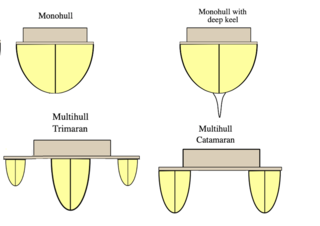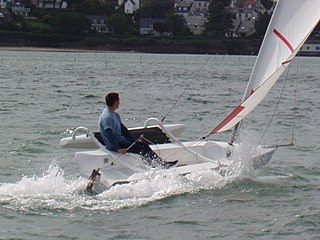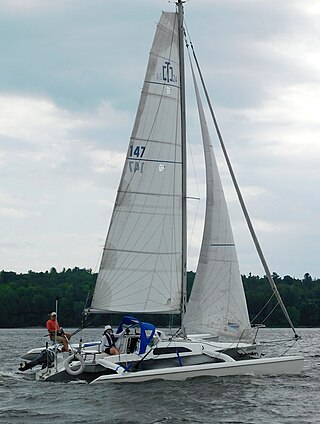Related Research Articles

A multihull is a boat or ship with more than one hull, whereas a vessel with a single hull is a monohull. The most common multihulls are catamarans, and trimarans. There are other types, with four or more hulls, but such examples are very rare and tend to be specialised for particular functions.

A sailboat or sailing boat is a boat propelled partly or entirely by sails and is smaller than a sailing ship. Distinctions in what constitutes a sailing boat and ship vary by region and maritime culture.

A catamaran is a watercraft with two parallel hulls of equal size. The distance between a catamaran's hulls imparts resistance to rolling and overturning. Catamarans typically have less hull volume, smaller displacement, and shallower draft (draught) than monohulls of comparable length. The two hulls combined also often have a smaller hydrodynamic resistance than comparable monohulls, requiring less propulsive power from either sails or motors. The catamaran's wider stance on the water can reduce both heeling and wave-induced motion, as compared with a monohull, and can give reduced wakes.

A trimaran is a multihull boat that comprises a main hull and two smaller outrigger hulls which are attached to the main hull with lateral beams. Most modern trimarans are sailing yachts designed for recreation or racing; others are ferries or warships. They originated from the traditional double-outrigger hulls of the Austronesian cultures of Maritime Southeast Asia; particularly in the Philippines and Eastern Indonesia, where it remains the dominant hull design of traditional fishing boats. Double-outriggers are derived from the older catamaran and single-outrigger boat designs.

An outrigger is a projecting structure on a boat, with specific meaning depending on types of vessel. Outriggers may also refer to legs on a wheeled vehicle that are folded out when it needs stabilization, for example on a crane that lifts heavy loads.

Proas are various types of multi-hull outrigger sailboats of the Austronesian peoples. The terms were used for native Austronesian ships in European records during the Colonial era indiscriminately, and thus can confusingly refer to the double-ended single-outrigger boats of Oceania, the double-outrigger boats of Island Southeast Asia, and sometimes ships with no outriggers or sails at all.

The beam of a ship is its width at its widest point. The maximum beam (BMAX) is the distance between planes passing through the outer sides of the ship, beam of the hull (BH) only includes permanently fixed parts of the hull, and beam at waterline (BWL) is the maximum width where the hull intersects the surface of the water.

A sailing hydrofoil, hydrofoil sailboat, or hydrosail is a sailboat with wing-like foils mounted under the hull. As the craft increases its speed the hydrofoils lift the hull up and out of the water, greatly reducing wetted area, resulting in decreased drag and increased speed. A sailing hydrofoil can achieve speeds exceeding double and in some cases triple the wind speed.

The Astus 16.1 is a 16 ft (5.1m) trimaran dinghy aimed at family day sailing. Its design has been optimised for simplicity of use: the traditional centreboard on the main hull has been replaced by foils built in each float.

A sailing yacht, is a leisure craft that uses sails as its primary means of propulsion. A yacht may be a sail or power vessel used for pleasure, cruising, or racing. There is no standard definition, so the term applies here to sailing vessels that have a cabin with amenities that accommodate overnight use. To be termed a "yacht", as opposed to a "boat", such a vessel is likely to be at least 33 feet (10 m) in length and have been judged to have good aesthetic qualities. Sailboats that do not accommodate overnight use or are smaller than 30 feet (9.1 m) are not universally called yachts. Sailing yachts in excess of 130 feet (40 m) are generally considered to be superyachts.

The Astus 14.1 is a 14 ft (4.18m) trimaran dinghy aimed at recreational sailing and racing. The trimaran design is unusual for a boat of this size but is said to combine the features of other types of design: pointing ability of a monohull dinghy, reaching ability of a catamaran, and planing ability of a skiff. The stability provided by the floats makes the boat accessible to beginners and single-handed racers.
Dragonfly Trimarans is a line of trimaran sailboats built by the Quorning Boats shipyard in Skærbæk, near Fredericia, Denmark.55°31′11.97″N9°38′8.08″E
Telstar trimarans is a line of trimarans most recently built by the Performance Cruising Inc shipyard in Annapolis, Maryland.
Farrier Marine is a catamaran and trimaran manufacturer based in Christchurch, New Zealand.

The F-27 Sport Cruiser is an American trailerable trimaran sailboat that was designed by New Zealander Ian Farrier in 1984–1985.
The Searunner 31 is a trimaran sailboat designed by Jim Brown in the 1960s. It is the most popular boat in the Searunner series, which includes models from 25 ft (7.6 m) to 40 ft (12 m).
John Westell was an English sailboat designer, who is noted for designing the 505 sailing dinghy and the Ocean Bird class of trimarans. Westell also designed cruising sailboats.

The F-31 Sport Cruiser is a family of American trailerable trimaran sailboats that was designed by New Zealander Ian Farrier and first built in 1991.

Polynesian multihull terminology, such as "ama", "aka" and "vaka" are multihull terms that have been widely adopted beyond the South Pacific where these terms originated. This Polynesian terminology is in common use in the Americas and the Pacific but is almost unknown in Europe, where the English terms "hull" and "outrigger" form normal parlance. Outriggers, catamarans, and outrigger boats are a common heritage of all Austronesian peoples and predate the Micronesian and Polynesian expansion into the Pacific. They are also the dominant forms of traditional ships in Island Southeast Asian and Malagasy Austronesian cultures, where local terms are used.

The Corsair 24, also called the Corsair F-24, is an American trailerable sailboat that was designed by Ian Farrier as a racer-cruiser. The boat was produced in two versions, the centerboard-equipped Mark I and the daggerboard Mark II.
References
- 1 2 David Owen (1970). "Trimariner: David Owen looks at the Ocean Bird, a cruising trimaran which offers speed with stability". Design Magazine.[ dead link ]
- ↑ "Ocean Bird 30—Sailboat specifications and details". sailboatdata.com. Retrieved 2018-05-17.